SpringSecurity(一)
目标:初步掌握Spring Security的认证功能实现。
案例介绍
- 项目的地址是: 项目初始化
- 项目的数据库脚本在src/main/resources目的下的security.sql。
- 开发工具使用的是IntelliJ IDEA。
- JDK版本是1.8。
- MySQL的版本是5.7。
- 后端的技术是SSM(SpringMVC、Spring、Mybatis)。
- 前端的技术是AdminLTE2。访问地址: http://localhost :8080/login.jsp。
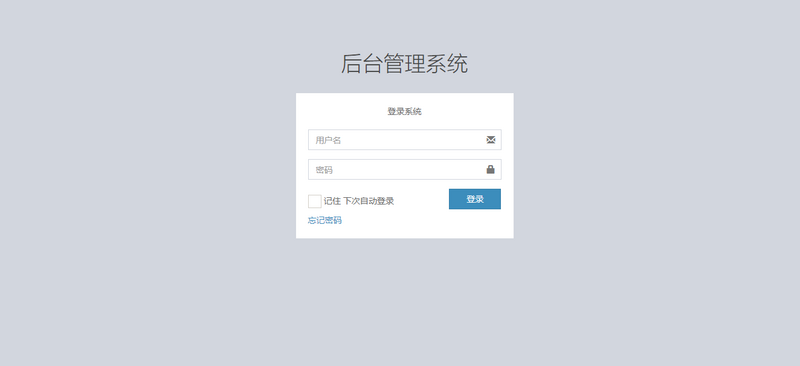
初识权限管理
权限管理概念
- 权限管理,一般是指根据系统设置的安全规则或安全策略,用户可以访问而且只能访问自己被授予的权限。权限管理几乎出现在任何系统里面,前提是需要用户认证的系统。
在权限管理的概念中,有两个非常重要的名词:
认证:通过用户名和密码(当然也可以是其它方式,比如邮箱、身份证等)成功登录系统后,让系统得到当前用户的角色身份。
授权:系统根据当前用户的角色,给其授予对应可以操作的权限资源。
完全权限管理需要三个对象
- 用户:主要包含用户名、密码等,可以实现认证操作。一般而言,在系统中给用户分配角色。
- 角色:角色是权限的集合。一般而言,在系统中给角色分配权限。
- 权限:权限也可以称为资源,包括地址、权限名称等。
一般而言,用户可以分配多个角色,角色可以分配多个权限。所以,在权限设计表的时候,一般设计5张表,分别为用户表、角色表、权限表、用户角色表、角色权限表。业内有时也会将这5张表称为经典的RBAC权限设计模型。
初识Spring Security
Spring Security概念
- Spring Security是Spring采用AOP思想,基于Servlet过滤器实现的安全框架。它提供了完善的认证机制和方法级的授权功能。是一个非常优秀的权限管理框架。
Spring Security简单入门
创建web工程并导入相应的jar包
<!--
spring-security-config是用来解析XML配置文件
-->
<dependency>
<groupId>org.springframework.security</groupId>
<artifactId>spring-security-config</artifactId>
<version>5.1.5.RELEASE</version>
</dependency>
<!--
spring-security-core是Spring Security的核心jar包,任何Spring Security都需要用此jar包
-->
<dependency>
<groupId>org.springframework.security</groupId>
<artifactId>spring-security-core</artifactId>
<version>5.1.5.RELEASE</version>
</dependency>
<!--
spring-security-taglibs是Spring Security提供的动态标签库,JSP页面中可以使用。
-->
<dependency>
<groupId>org.springframework.security</groupId>
<artifactId>spring-security-taglibs</artifactId>
<version>5.1.5.RELEASE</version>
</dependency>
<!--
spring-security-web是web工程的必备jar包,包含过滤器和相关的web安全基础结构代码
-->
<dependency>
<groupId>org.springframework.security</groupId>
<artifactId>spring-security-web</artifactId>
<version>5.1.5.RELEASE</version>
</dependency>
配置web.xml
<!-- 配置Spring Security的核心过滤器链 -->
<!--
filter-name必须是springSecurityFilterChain
-->
<filter>
<filter-name>springSecurityFilterChain</filter-name>
<filter-class>org.springframework.web.filter.DelegatingFilterProxy</filter-class>
</filter>
<filter-mapping>
<filter-name>springSecurityFilterChain</filter-name>
<url-pattern>/*</url-pattern>
</filter-mapping>
配置spring-security.xml
<?xml version="1.0" encoding="UTF-8"?>
<beans xmlns="http://www.springframework.org/schema/beans"
xmlns:xsi="http://www.w3.org/2001/XMLSchema-instance"
xmlns:context="http://www.springframework.org/schema/context"
xmlns:aop="http://www.springframework.org/schema/aop"
xmlns:tx="http://www.springframework.org/schema/tx"
xmlns:mvc="http://www.springframework.org/schema/mvc"
xmlns:security="http://www.springframework.org/schema/security"
xsi:schemaLocation="http://www.springframework.org/schema/beans
http://www.springframework.org/schema/beans/spring-beans.xsd
http://www.springframework.org/schema/context
http://www.springframework.org/schema/context/spring-context.xsd
http://www.springframework.org/schema/aop
http://www.springframework.org/schema/aop/spring-aop.xsd
http://www.springframework.org/schema/tx
http://www.springframework.org/schema/tx/spring-tx.xsd
http://www.springframework.org/schema/mvc
http://www.springframework.org/schema/mvc/spring-mvc.xsd
http://www.springframework.org/schema/security
http://www.springframework.org/schema/security/spring-security.xsd">
<!--
配置Spring Security
auto-config="true"表示自定加载spring-security.xml配置文件
use-expressions="true"表示使用spring的el表达式来配置spring security
-->
<security:http auto-config="true" use-expressions="true">
<!-- 拦截资源 -->
<!--
pattern="/**" 表示拦截所有的资源
access="hasAnyRole('ROLE_USER')" 表示只有ROLE_USER的角色才能访问资源
-->
<security:intercept-url pattern="/**" access="hasAnyRole('ROLE_USER')"/>
</security:http>
<!--设置Spring Security认证用户信息的来源-->
<!--
Spring Security的认证必须是加密的,{noop}表示不加密认证
-->
<security:authentication-manager>
<security:authentication-provider>
<security:user-service>
<security:user name="user" password="{noop}user"
authorities="ROLE_USER"/>
<security:user name="admin" password="{noop}admin"
authorities="ROLE_ADMIN"/>
</security:user-service>
</security:authentication-provider>
</security:authentication-manager>
</beans>
将spring-security.xml配置文件引入到applicationContext.xml中
<!--引入SpringSecurity主配置文件--> <import resource="classpath:spring-security.xml"/>
运行项目
- 运行项目会出现下面的界面。

- 其源码如下:

- 控制台的日志:
INFO web.DefaultSecurityFilterChain - Creating filter chain: any request, [org.springframework.security.web.context.SecurityContextPersistenceFilter@17455fed, org.springframework.security.web.context.request.async.WebAsyncManagerIntegrationFilter@97f4fa3, org.springframework.security.web.header.HeaderWriterFilter@1384edda, org.springframework.security.web.csrf.CsrfFilter@544ac02d, org.springframework.security.web.authentication.logout.LogoutFilter@694d477e, org.springframework.security.web.authentication.UsernamePasswordAuthenticationFilter@1abc0fa3, org.springframework.security.web.authentication.ui.DefaultLoginPageGeneratingFilter@2e62db13, org.springframework.security.web.authentication.ui.DefaultLogoutPageGeneratingFilter@2c2b3d5a, org.springframework.security.web.authentication.www.BasicAuthenticationFilter@2fdef916, org.springframework.security.web.savedrequest.RequestCacheAwareFilter@55e53a59, org.springframework.security.web.servletapi.SecurityContextHolderAwareRequestFilter@6d67c9b5, org.springframework.security.web.authentication.AnonymousAuthenticationFilter@18d3e8ae, org.springframework.security.web.session.SessionManagementFilter@409db4eb, org.springframework.security.web.access.ExceptionTranslationFilter@3cd67953, org.springframework.security.web.access.intercept.FilterSecurityInterceptor@6faf351d]
- 最后,我们在此登录页面输入用户名为user,密码为user,即可登录。

Spring Security常用的过滤器链
Spring Security常用过滤器介绍
- org.springframework.security.web.context.SecurityContextPersistenceFilter
SecurityContextPersistenceFilter主要是使用SecurityContextRepository在session中保存或更新一个SecurityContext,并将SecurityContext给以后的过滤器使用个,为后续Filter建立所需要的上下文。SecurityContext中存储了当前用户的认证和权限信息。
- org.springframework.security.web.context.request.async.WebAsyncManagerIntegrationFilter
此过滤器用语集成SecurityContext到Spring异步执行机制中的WebAsyncManager。
- org.springframework.security.web.header.HeaderWriterFilter
向请求的Header中添加相应的信息,可在http标签内部使用security:headers来控制。
- org.springframework.security.web.csrf.CsrfFilter
csrf又称为跨域请求伪造,SpringSecurity会对所有POST、PUT、DELETE请求验证是否包含系统生成的csrf的token信息,如果不包含,就报错。起到防止csrf攻击的效果。
- org.springframework.security.web.authentication.logout.LogoutFilter
匹配URL为/logout的请求,实现用户退出,清除认证信息。
- org.springframework.security.web.authentication.UsernamePasswordAuthenticationFilter
认证操作全靠这个过滤器,默认匹配URL为/login且必须为POST请求。
- org.springframework.security.web.authentication.ui.DefaultLoginPageGeneratingFilter
如果没有在配置文件中执行认证页面,则由该过滤器生成一个默认认证页面。
- org.springframework.security.web.authentication.ui.DefaultLogoutPageGeneratingFilter
此过滤器产生的一个默认的退出登录的页面。
- org.springframework.security.web.authentication.www.BasicAuthenticationFilter
此过滤器会自动解析HTTP请求中头部带有Authentication,且以Basic开头的头信息。
- org.springframework.security.web.savedrequest.RequestCacheAwareFilter
通过HttpSessionRequestCache内部维护了一个RequestCache,用于缓存HttpServletRequest。
- org.springframework.security.web.servletapi.SecurityContextHolderAwareRequestFilter
针对ServletRequest进行了一次包装,使得request具有更加丰富的API。
- org.springframework.security.web.authentication.AnonymousAuthenticationFilter
当SecurityContextHolder中认证信息为空,则会创建一个匿名用户存入到SecurityContextHolder中,SpringSecurity为了兼容未登录的访问,也走了一套认证流程,只不过是一个匿名身份。
- org.springframework.security.web.session.SessionManagementFilter
SecurityContextRepository限制同一用户开启多个会话的数量。
- org.springframework.security.web.access.ExceptionTranslationFilter
异常转换过滤器位于整个SpringSecurityFilterChain的后方,用来转换整个链路中出现的异常。
- org.springframework.security.web.access.intercept.FilterSecurityInterceptor
获取所配置资源访问的授权信息,根据SecurityContextHolder中存储的用户信息来决定其是否有权限。
Spring Security过滤器链加载原理
DelegatingFilterProxy
- 我们在web.xml中配置了一个名称为springSecurityFilterChain的过滤器DelegatingFilterProxy,接下来我们看其中的重要源码即可。
public class DelegatingFilterProxy extends GenericFilterBean {
@Nullable
private String contextAttribute;
@Nullable
private WebApplicationContext webApplicationContext;
@Nullable
private String targetBeanName;
private boolean targetFilterLifecycle = false;
@Nullable
private volatile Filter delegate; //注意:这个过滤器才是真正加载的过滤器
private final Object delegateMonitor = new Object();
//注意:doFilter是过滤器的入口,直接从这边看。
@Override
public void doFilter(ServletRequest request, ServletResponse response, FilterChain filterChain)
throws ServletException, IOException {
Filter delegateToUse = this.delegate;
if (delegateToUse == null) {
synchronized (this.delegateMonitor) {
delegateToUse = this.delegate;
if (delegateToUse == null) {
WebApplicationContext wac = findWebApplicationContext();
if (wac == null) {
throw new IllegalStateException("No WebApplicationContext found: " +
"no ContextLoaderListener or DispatcherServlet registered?");
}
//第一步:doFilter中最重要的一步,初始化上面私有过滤器属性delegate
delegateToUse = initDelegate(wac);
}
this.delegate = delegateToUse;
}
}
//第三步:执行FilterChainProxy过滤器
invokeDelegate(delegateToUse, request, response, filterChain);
}
//第二步:直接看最终加载的过滤器是谁
protected Filter initDelegate(WebApplicationContext wac) throws ServletException {
//debug得知targetBeanName为springSecurityFilterChain
String targetBeanName = getTargetBeanName();
Assert.state(targetBeanName != null, "No target bean name set");
//debug得知Filter对象为FilterChainProxy
Filter delegate = wac.getBean(targetBeanName, Filter.class);
if (isTargetFilterLifecycle()) {
delegate.init(getFilterConfig());
}
return delegate;
}
protected void invokeDelegate(
Filter delegate, ServletRequest request, ServletResponse response, FilterChain filterChain)
throws ServletException, IOException {
delegate.doFilter(request, response, filterChain);
}
}
- 第二步debug的结果如下图所示:
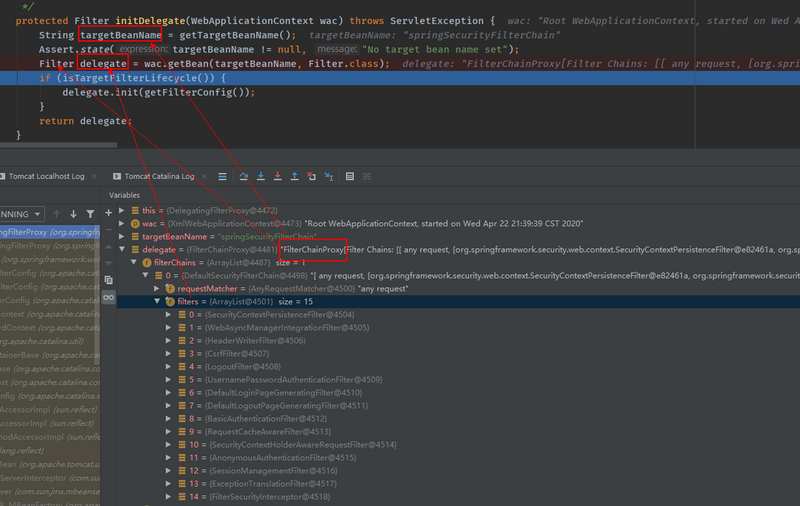
- 由此可知,DelegatingFilterProxy通过springSecurityFilterChain这个名词,得到了一个FilterChainProxy过滤器,最终在第三步执行了该过滤器。
FilterChainProxy
public class FilterChainProxy extends GenericFilterBean {
private static final Log logger = LogFactory.getLog(FilterChainProxy.class);
private static final String FILTER_APPLIED = FilterChainProxy.class.getName().concat(".APPLIED");
private List<SecurityFilterChain> filterChains;
private FilterChainProxy.FilterChainValidator filterChainValidator;
private HttpFirewall firewall;
//可以通过一个叫SecurityFilterChain的对象实例化一个FilterChainProxy对象,可能SecurityFilterChain才是真正的过滤器对象。
public FilterChainProxy(SecurityFilterChain chain) {
this(Arrays.asList(chain));
}
//又是SecurityFilterChain对象。
public FilterChainProxy(List<SecurityFilterChain> filterChains) {
this.filterChainValidator = new FilterChainProxy.NullFilterChainValidator();
this.firewall = new StrictHttpFirewall();
this.filterChains = filterChains;
}
//注意:直接从doFilter看
public void doFilter(ServletRequest request, ServletResponse response, FilterChain chain) throws IOException, ServletException {
boolean clearContext = request.getAttribute(FILTER_APPLIED) == null;
if (clearContext) {
try {
request.setAttribute(FILTER_APPLIED, Boolean.TRUE);
this.doFilterInternal(request, response, chain);
} finally {
SecurityContextHolder.clearContext();
request.removeAttribute(FILTER_APPLIED);
}
} else {
//第一步:具体操作调用下面的doFilterInternal方法
this.doFilterInternal(request, response, chain);
}
}
private void doFilterInternal(ServletRequest request, ServletResponse response, FilterChain chain) throws IOException, ServletException {
FirewalledRequest fwRequest = this.firewall.getFirewalledRequest((HttpServletRequest)request);
HttpServletResponse fwResponse = this.firewall.getFirewalledResponse((HttpServletResponse)response);
//第二步:封装要执行的过滤器链,这么多的过滤器链就在这里封装进去了。
List<Filter> filters = this.getFilters((HttpServletRequest)fwRequest);
if (filters != null && filters.size() != 0) {
FilterChainProxy.VirtualFilterChain vfc = new FilterChainProxy.VirtualFilterChain(fwRequest, chain, filters);
//第四步:加载过滤器链
vfc.doFilter(fwRequest, fwResponse);
} else {
if (logger.isDebugEnabled()) {
logger.debug(UrlUtils.buildRequestUrl(fwRequest) + (filters == null ? " has no matching filters" : " has an empty filter list"));
}
fwRequest.reset();
chain.doFilter(fwRequest, fwResponse);
}
}
private List<Filter> getFilters(HttpServletRequest request) {
Iterator var2 = this.filterChains.iterator();
//封装过滤器链到SecurityFilterChain对象
SecurityFilterChain chain;
do {
if (!var2.hasNext()) {
return null;
}
chain = (SecurityFilterChain)var2.next();
} while(!chain.matches(request));
return chain.getFilters();
}
}
- 第二步debug的结果如下图所示:
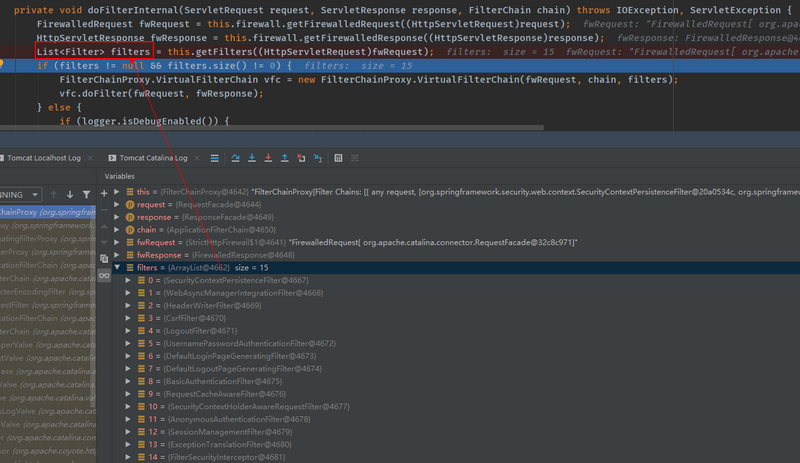
SecurityFilterChain
- SecurityFilterChain是一个接口,实现类也只有一个,这才是web.xml配置的过滤器链对象。
//接口
public interface SecurityFilterChain {
boolean matches(HttpServletRequest var1);
List<Filter> getFilters();
}
//实现类
public final class DefaultSecurityFilterChain implements SecurityFilterChain {
private static final Log logger = LogFactory.getLog(DefaultSecurityFilterChain.class);
private final RequestMatcher requestMatcher;
private final List<Filter> filters;
public DefaultSecurityFilterChain(RequestMatcher requestMatcher, Filter... filters) {
this(requestMatcher, Arrays.asList(filters));
}
public DefaultSecurityFilterChain(RequestMatcher requestMatcher, List<Filter> filters) {
logger.info("Creating filter chain: " + requestMatcher + ", " + filters);
this.requestMatcher = requestMatcher;
this.filters = new ArrayList(filters);
}
public RequestMatcher getRequestMatcher() {
return this.requestMatcher;
}
public List<Filter> getFilters() {
return this.filters;
}
public boolean matches(HttpServletRequest request) {
return this.requestMatcher.matches(request);
}
public String toString() {
return "[ " + this.requestMatcher + ", " + this.filters + "]";
}
}
SpringSecurity使用自定义认证页面
在SpringSecurity的主配置文件中指定认证页面配置信息
<?xml version="1.0" encoding="UTF-8"?>
<beans xmlns="http://www.springframework.org/schema/beans"
xmlns:xsi="http://www.w3.org/2001/XMLSchema-instance"
xmlns:context="http://www.springframework.org/schema/context"
xmlns:aop="http://www.springframework.org/schema/aop"
xmlns:tx="http://www.springframework.org/schema/tx"
xmlns:mvc="http://www.springframework.org/schema/mvc"
xmlns:security="http://www.springframework.org/schema/security"
xsi:schemaLocation="http://www.springframework.org/schema/beans
http://www.springframework.org/schema/beans/spring-beans.xsd
http://www.springframework.org/schema/context
http://www.springframework.org/schema/context/spring-context.xsd
http://www.springframework.org/schema/aop
http://www.springframework.org/schema/aop/spring-aop.xsd
http://www.springframework.org/schema/tx
http://www.springframework.org/schema/tx/spring-tx.xsd
http://www.springframework.org/schema/mvc
http://www.springframework.org/schema/mvc/spring-mvc.xsd
http://www.springframework.org/schema/security
http://www.springframework.org/schema/security/spring-security.xsd">
<!--直接释放无需经过SpringSecurity过滤器的静态资源-->
<security:http pattern="/css/**" security="none"/>
<security:http pattern="/img/**" security="none"/>
<security:http pattern="/plugins/**" security="none"/>
<security:http pattern="/failer.jsp" security="none"/>
<security:http pattern="/favicon.ico" security="none"/>
<!--
配置Spring Security
auto-config="true"表示自定加载spring-security.xml配置文件
use-expressions="true"表示使用spring的el表达式来配置spring security
-->
<security:http auto-config="true" use-expressions="true">
<!--指定login.jsp页面可以被匿名访问-->
<security:intercept-url pattern="/login.jsp" access="permitAll()"/>
<!-- 拦截资源 -->
<!--
pattern="/**" 表示拦截所有的资源
access="hasAnyRole('ROLE_USER')" 表示只有ROLE_USER的角色才能访问资源
-->
<security:intercept-url pattern="/**" access="hasAnyRole('ROLE_USER')"/>
<!-- 配置认证信息,指定自定义的认证页面 -->
<!--
login-page 指定登录页面的地址
login-processing-url 处理登录的处理器的地址
default-target-url 登录成功跳转的地址
authentication-failure-url 登录失败跳转的地址
默认的用户名是username,密码是password,当然也可以使用username-parameter和password-parameter修改。
-->
<security:form-login login-page="/login.jsp"
login-processing-url="/login"
default-target-url="/index.jsp"
authentication-failure-url="/failer.jsp"/>
<!--
指定退出登录后跳转的页面
logout-url 处理退出登录的处理器地址
logout-success-url 退出登录成功跳转的地址
-->
<security:logout logout-url="/logout" logout-success-url="/login.jsp"/>
</security:http>
<!--设置Spring Security认证用户信息的来源-->
<!--
Spring Security的认证必须是加密的,{noop}表示不加密认证
-->
<security:authentication-manager>
<security:authentication-provider>
<security:user-service>
<security:user name="user" password="{noop}user"
authorities="ROLE_USER"/>
<security:user name="admin" password="{noop}admin"
authorities="ROLE_ADMIN"/>
</security:user-service>
</security:authentication-provider>
</security:authentication-manager>
</beans>
- 修改认证页面的请求地址:
<%@ page language="java" contentType="text/html; charset=UTF-8" pageEncoding="UTF-8"%>
<!DOCTYPE html PUBLIC "-//W3C//DTD HTML 4.01 Transitional//EN" "http://www.w3.org/TR/html4/loose.dtd">
<html>
<head>
<meta charset="utf-8">
<meta http-equiv="X-UA-Compatible" content="IE=edge">
<title>数据 - AdminLTE2定制版 | Log in</title>
<meta
content="width=device-width,initial-scale=1,maximum-scale=1,user-scalable=no"
name="viewport">
<link rel="stylesheet"
href="${pageContext.request.contextPath}/plugins/bootstrap/css/bootstrap.min.css">
<link rel="stylesheet"
href="${pageContext.request.contextPath}/plugins/font-awesome/css/font-awesome.min.css">
<link rel="stylesheet"
href="${pageContext.request.contextPath}/plugins/ionicons/css/ionicons.min.css">
<link rel="stylesheet"
href="${pageContext.request.contextPath}/plugins/adminLTE/css/AdminLTE.css">
<link rel="stylesheet"
href="${pageContext.request.contextPath}/plugins/iCheck/square/blue.css">
</head>
<body class="hold-transition login-page">
<div class="login-box">
<div class="login-logo">
<a href="#"><b></b>后台管理系统</a>
</div>
<!-- /.login-logo -->
<div class="login-box-body">
<p class="login-box-msg">登录系统</p>
<!--
action的地址必须是/login
method 必须是post
-->
<form action="${pageContext.request.contextPath}/login" method="post">
<div class="form-group has-feedback">
<input type="text" name="username" class="form-control"
placeholder="用户名"> <span
class="glyphicon glyphicon-envelope form-control-feedback"></span>
</div>
<div class="form-group has-feedback">
<input type="password" name="password" class="form-control"
placeholder="密码"> <span
class="glyphicon glyphicon-lock form-control-feedback"></span>
</div>
<div class="row">
<div class="col-xs-8">
<div class="checkbox icheck">
<label><input type="checkbox" name="remember-me" value="true"> 记住 下次自动登录</label>
</div>
</div>
<!-- /.col -->
<div class="col-xs-4">
<button type="submit" class="btn btn-primary btn-block btn-flat">登录</button>
</div>
<!-- /.col -->
</div>
</form>
<a href="#">忘记密码</a><br>
</div>
<!-- /.login-box-body -->
</div>
<!-- /.login-box -->
<!-- jQuery 2.2.3 -->
<!-- Bootstrap 3.3.6 -->
<!-- iCheck -->
<script
src="${pageContext.request.contextPath}/plugins/jQuery/jquery-2.2.3.min.js"></script>
<script
src="${pageContext.request.contextPath}/plugins/bootstrap/js/bootstrap.min.js"></script>
<script
src="${pageContext.request.contextPath}/plugins/iCheck/icheck.min.js"></script>
<script>
$(function() {
$('input').iCheck({
checkboxClass : 'icheckbox_square-blue',
radioClass : 'iradio_square-blue',
increaseArea : '20%' // optional
});
});
</script>
</body>
</html>
- 再次启动项目就可以看到自定义的登录页面了。
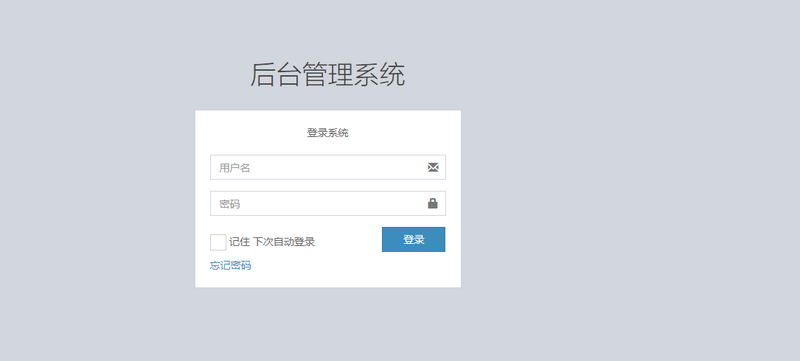
- 但是当我们输入用户名为user,密码为user的时候,却会出现如下的页面:
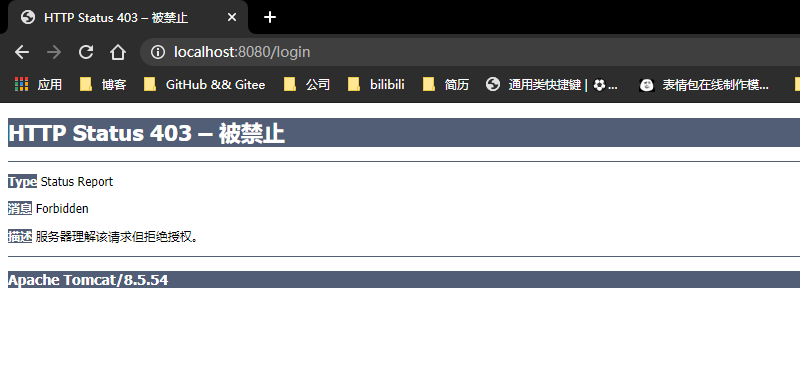
- 403在Spring Security中是权限不足?为什么?Spring Security内置的认证页面源代码中有_csrf隐藏input,问题就在这里,而且后台日志是这样的。

Spring Security的csrf防护机制
Spring Security中CsrfFilter过滤器的说明
public final class CsrfFilter extends OncePerRequestFilter {
public static final RequestMatcher DEFAULT_CSRF_MATCHER = new CsrfFilter.DefaultRequiresCsrfMatcher();
private final Log logger = LogFactory.getLog(this.getClass());
private final CsrfTokenRepository tokenRepository;
private RequestMatcher requireCsrfProtectionMatcher;
private AccessDeniedHandler accessDeniedHandler;
public CsrfFilter(CsrfTokenRepository csrfTokenRepository) {
this.requireCsrfProtectionMatcher = DEFAULT_CSRF_MATCHER;
this.accessDeniedHandler = new AccessDeniedHandlerImpl();
Assert.notNull(csrfTokenRepository, "csrfTokenRepository cannot be null");
this.tokenRepository = csrfTokenRepository;
}
//从这里可以看出Spring Security的csrf机制把请求方式分为两类
protected void doFilterInternal(HttpServletRequest request, HttpServletResponse response, FilterChain filterChain) throws ServletException, IOException {
request.setAttribute(HttpServletResponse.class.getName(), response);
CsrfToken csrfToken = this.tokenRepository.loadToken(request);
boolean missingToken = csrfToken == null;
if (missingToken) {
csrfToken = this.tokenRepository.generateToken(request);
this.tokenRepository.saveToken(csrfToken, request, response);
}
request.setAttribute(CsrfToken.class.getName(), csrfToken);
request.setAttribute(csrfToken.getParameterName(), csrfToken);
//第一类:GET、HEAD、TRACE、OPTIONS四类请求可以直接通过
if (!this.requireCsrfProtectionMatcher.matches(request)) {
filterChain.doFilter(request, response);
} else {
//第二类:除去上面的四种方式,包括POST、DELETE、PUT等都需要携带token才能通过
String actualToken = request.getHeader(csrfToken.getHeaderName());
if (actualToken == null) {
actualToken = request.getParameter(csrfToken.getParameterName());
}
if (!csrfToken.getToken().equals(actualToken)) {
if (this.logger.isDebugEnabled()) {
this.logger.debug("Invalid CSRF token found for " + UrlUtils.buildFullRequestUrl(request));
}
if (missingToken) {
this.accessDeniedHandler.handle(request, response, new MissingCsrfTokenException(actualToken));
} else {
this.accessDeniedHandler.handle(request, response, new InvalidCsrfTokenException(csrfToken, actualToken));
}
} else {
filterChain.doFilter(request, response);
}
}
}
public void setRequireCsrfProtectionMatcher(RequestMatcher requireCsrfProtectionMatcher) {
Assert.notNull(requireCsrfProtectionMatcher, "requireCsrfProtectionMatcher cannot be null");
this.requireCsrfProtectionMatcher = requireCsrfProtectionMatcher;
}
public void setAccessDeniedHandler(AccessDeniedHandler accessDeniedHandler) {
Assert.notNull(accessDeniedHandler, "accessDeniedHandler cannot be null");
this.accessDeniedHandler = accessDeniedHandler;
}
private static final class DefaultRequiresCsrfMatcher implements RequestMatcher {
private final HashSet<String> allowedMethods;
private DefaultRequiresCsrfMatcher() {
this.allowedMethods = new HashSet(Arrays.asList("GET", "HEAD", "TRACE", "OPTIONS"));
}
public boolean matches(HttpServletRequest request) {
return !this.allowedMethods.contains(request.getMethod());
}
}
}
-
通过源码,我们知道,我们自己的登录页面的请求方式是POST,但是却没有携带token,所以才会出现403权限不足的异常,那么如何处理?
- ①直接禁用csrf,不推荐。
- ②在认证页面携带token请求。
禁用csrf防护机制
- 在Spring Security的主配置文件中添加禁用csrf防护的机制。
<?xml version="1.0" encoding="UTF-8"?>
<beans xmlns="http://www.springframework.org/schema/beans"
xmlns:xsi="http://www.w3.org/2001/XMLSchema-instance"
xmlns:context="http://www.springframework.org/schema/context"
xmlns:aop="http://www.springframework.org/schema/aop"
xmlns:tx="http://www.springframework.org/schema/tx"
xmlns:mvc="http://www.springframework.org/schema/mvc"
xmlns:security="http://www.springframework.org/schema/security"
xsi:schemaLocation="http://www.springframework.org/schema/beans
http://www.springframework.org/schema/beans/spring-beans.xsd
http://www.springframework.org/schema/context
http://www.springframework.org/schema/context/spring-context.xsd
http://www.springframework.org/schema/aop
http://www.springframework.org/schema/aop/spring-aop.xsd
http://www.springframework.org/schema/tx
http://www.springframework.org/schema/tx/spring-tx.xsd
http://www.springframework.org/schema/mvc
http://www.springframework.org/schema/mvc/spring-mvc.xsd
http://www.springframework.org/schema/security
http://www.springframework.org/schema/security/spring-security.xsd">
<!--直接释放无需经过SpringSecurity过滤器的静态资源-->
<security:http pattern="/css/**" security="none"/>
<security:http pattern="/img/**" security="none"/>
<security:http pattern="/plugins/**" security="none"/>
<security:http pattern="/failer.jsp" security="none"/>
<security:http pattern="/favicon.ico" security="none"/>
<!--
配置Spring Security
auto-config="true"表示自定加载spring-security.xml配置文件
use-expressions="true"表示使用spring的el表达式来配置spring security
-->
<security:http auto-config="true" use-expressions="true">
<!--指定login.jsp页面可以被匿名访问-->
<security:intercept-url pattern="/login.jsp" access="permitAll()"/>
<!-- 拦截资源 -->
<!--
pattern="/**" 表示拦截所有的资源
access="hasAnyRole('ROLE_USER')" 表示只有ROLE_USER的角色才能访问资源
-->
<security:intercept-url pattern="/**" access="hasAnyRole('ROLE_USER')"/>
<!-- 配置认证信息,指定自定义的认证页面 -->
<!--
login-page 指定登录页面的地址
login-processing-url 处理登录的处理器的地址
default-target-url 登录成功跳转的地址
authentication-failure-url 登录失败跳转的地址
默认的用户名是username,密码是password,当然也可以使用username-parameter和password-parameter修改。
-->
<security:form-login login-page="/login.jsp"
login-processing-url="/login"
default-target-url="/index.jsp"
authentication-failure-url="/failer.jsp"/>
<!--
指定退出登录后跳转的页面
logout-url 处理退出登录的处理器的地址
logout-success-url 退出登录成功跳转的地址
-->
<security:logout logout-url="/logout" logout-success-url="/login.jsp"/>
<!-- 禁用csrf防护机制 -->
<security:csrf disabled="true"/>
</security:http>
<!--设置Spring Security认证用户信息的来源-->
<!--
Spring Security的认证必须是加密的,{noop}表示不加密认证
-->
<security:authentication-manager>
<security:authentication-provider>
<security:user-service>
<security:user name="user" password="{noop}user"
authorities="ROLE_USER"/>
<security:user name="admin" password="{noop}admin"
authorities="ROLE_ADMIN"/>
</security:user-service>
</security:authentication-provider>
</security:authentication-manager>
</beans>
在认证页面携带token请求
<%@ page language="java" contentType="text/html; charset=UTF-8" pageEncoding="UTF-8"%>
<%-- 添加标签库 --%>
<%@taglib prefix="security" uri="http://www.springframework.org/security/tags" %>
<!DOCTYPE html PUBLIC "-//W3C//DTD HTML 4.01 Transitional//EN" "http://www.w3.org/TR/html4/loose.dtd">
<html>
<head>
<meta charset="utf-8">
<meta http-equiv="X-UA-Compatible" content="IE=edge">
<title>数据 - AdminLTE2定制版 | Log in</title>
<meta
content="width=device-width,initial-scale=1,maximum-scale=1,user-scalable=no"
name="viewport">
<link rel="stylesheet"
href="${pageContext.request.contextPath}/plugins/bootstrap/css/bootstrap.min.css">
<link rel="stylesheet"
href="${pageContext.request.contextPath}/plugins/font-awesome/css/font-awesome.min.css">
<link rel="stylesheet"
href="${pageContext.request.contextPath}/plugins/ionicons/css/ionicons.min.css">
<link rel="stylesheet"
href="${pageContext.request.contextPath}/plugins/adminLTE/css/AdminLTE.css">
<link rel="stylesheet"
href="${pageContext.request.contextPath}/plugins/iCheck/square/blue.css">
</head>
<body class="hold-transition login-page">
<div class="login-box">
<div class="login-logo">
<a href="#"><b></b>后台管理系统</a>
</div>
<!-- /.login-logo -->
<div class="login-box-body">
<p class="login-box-msg">登录系统</p>
<form action="${pageContext.request.contextPath}/login" method="post">
<%-- 在认证页面携带token --%>
<security:csrfInput/>
<div class="form-group has-feedback">
<input type="text" name="username" class="form-control"
placeholder="用户名"> <span
class="glyphicon glyphicon-envelope form-control-feedback"></span>
</div>
<div class="form-group has-feedback">
<input type="password" name="password" class="form-control"
placeholder="密码"> <span
class="glyphicon glyphicon-lock form-control-feedback"></span>
</div>
<div class="row">
<div class="col-xs-8">
<div class="checkbox icheck">
<label><input type="checkbox" name="remember-me" value="true"> 记住 下次自动登录</label>
</div>
</div>
<!-- /.col -->
<div class="col-xs-4">
<button type="submit" class="btn btn-primary btn-block btn-flat">登录</button>
</div>
<!-- /.col -->
</div>
</form>
<a href="#">忘记密码</a><br>
</div>
<!-- /.login-box-body -->
</div>
<!-- /.login-box -->
<!-- jQuery 2.2.3 -->
<!-- Bootstrap 3.3.6 -->
<!-- iCheck -->
<script
src="${pageContext.request.contextPath}/plugins/jQuery/jquery-2.2.3.min.js"></script>
<script
src="${pageContext.request.contextPath}/plugins/bootstrap/js/bootstrap.min.js"></script>
<script
src="${pageContext.request.contextPath}/plugins/iCheck/icheck.min.js"></script>
<script>
$(function() {
$('input').iCheck({
checkboxClass : 'icheckbox_square-blue',
radioClass : 'iradio_square-blue',
increaseArea : '20%' // optional
});
});
</script>
</body>
</html>
注销
- 需要将header.jsp中的注销功能,改为form表单提交,并且提交的方式是POST提交,而且在表单携带token请求。
<%@ page language="java" contentType="text/html; charset=UTF-8" pageEncoding="UTF-8" %>
<%@taglib prefix="security" uri="http://www.springframework.org/security/tags" %>
<!-- 页面头部 -->
<header class="main-header">
<!-- Logo -->
<a href="${pageContext.request.contextPath}/pages/main.jsp" class="logo">
<!-- mini logo for sidebar mini 50x50 pixels -->
<span class="logo-mini"><b>数据</b></span> <!-- logo for regular state and mobile devices -->
<span class="logo-lg"><b>数据</b>后台管理</span>
</a>
<!-- Header Navbar: style can be found in header.less -->
<nav class="navbar navbar-static-top">
<!-- Sidebar toggle button-->
<a href="#" class="sidebar-toggle" data-toggle="offcanvas"
role="button"> <span class="sr-only">Toggle navigation</span>
</a>
<div class="navbar-custom-menu">
<ul class="nav navbar-nav">
<li class="dropdown user user-menu"><a href="#"
class="dropdown-toggle" data-toggle="dropdown"> <img
src="${pageContext.request.contextPath}/img/user2-160x160.jpg"
class="user-image" alt="User Image">
<span class="hidden-xs">
<%--<security:authentication property="principal.username" />--%>
<%--<security:authentication property="name" />--%>
</span>
</a>
<ul class="dropdown-menu">
<!-- User image -->
<li class="user-header"><img
src="${pageContext.request.contextPath}/img/user2-160x160.jpg"
class="img-circle" alt="User Image"></li>
<!-- Menu Footer-->
<li class="user-footer">
<div class="pull-left">
<a href="#" class="btn btn-default btn-flat">修改密码</a>
</div>
<div class="pull-right">
<%-- 将原来的注销注释,使用form表单的形式提交,在表单携带token请求 --%>
<%-- <a href="${pageContext.request.contextPath}/login.jsp"--%>
<%-- class="btn btn-default btn-flat">注销</a>--%>
<form action="${pageContext.request.contextPath}/logout" method="post">
<security:csrfInput/>
<input type="submit" class="btn btn-default btn-flat">注销</input>
</form>
</div>
</li>
</ul>
</li>
</ul>
</div>
</nav>
</header>
<!-- 页面头部 /-->
Spring Security使用数据库完成认证
认证流程分析
UsernamePasswordAuthenticationFilter
UsernamePasswordAuthenticationFilter是用来负责认证的过滤器。
package org.springframework.security.web.authentication;
public class UsernamePasswordAuthenticationFilter extends AbstractAuthenticationProcessingFilter {
public static final String SPRING_SECURITY_FORM_USERNAME_KEY = "username";
public static final String SPRING_SECURITY_FORM_PASSWORD_KEY = "password";
private String usernameParameter = "username";
private String passwordParameter = "password";
private boolean postOnly = true;
public UsernamePasswordAuthenticationFilter() {
super(new AntPathRequestMatcher("/login", "POST"));
}
//视图认证的方法
public Authentication attemptAuthentication(HttpServletRequest request, HttpServletResponse response) throws AuthenticationException {
//必须为POST请求,否则会抛出异常
if (this.postOnly && !request.getMethod().equals("POST")) {
throw new AuthenticationServiceException("Authentication method not supported: " + request.getMethod());
} else {
String username = this.obtainUsername(request);
String password = this.obtainPassword(request);
if (username == null) {
username = "";
}
if (password == null) {
password = "";
}
username = username.trim();
//将填写的用户名和密码封装到UsernamePasswordAuthenticationToken对象中
UsernamePasswordAuthenticationToken authRequest = new UsernamePasswordAuthenticationToken(username, password);
this.setDetails(request, authRequest);
//调用AuthenticationManager对应进行认证
return this.getAuthenticationManager().authenticate(authRequest);
}
}
protected String obtainPassword(HttpServletRequest request) {
return request.getParameter(this.passwordParameter);
}
protected String obtainUsername(HttpServletRequest request) {
return request.getParameter(this.usernameParameter);
}
protected void setDetails(HttpServletRequest request, UsernamePasswordAuthenticationToken authRequest) {
authRequest.setDetails(this.authenticationDetailsSource.buildDetails(request));
}
public void setUsernameParameter(String usernameParameter) {
Assert.hasText(usernameParameter, "Username parameter must not be empty or null");
this.usernameParameter = usernameParameter;
}
public void setPasswordParameter(String passwordParameter) {
Assert.hasText(passwordParameter, "Password parameter must not be empty or null");
this.passwordParameter = passwordParameter;
}
public void setPostOnly(boolean postOnly) {
this.postOnly = postOnly;
}
public final String getUsernameParameter() {
return this.usernameParameter;
}
public final String getPasswordParameter() {
return this.passwordParameter;
}
}
AuthenticationManager
- 由上面的源码可知,真正的认证操作在AuthenticationManager里面。但是AuthenticationManager是接口,其子类是ProviderManager。
public class ProviderManager implements AuthenticationManager, MessageSourceAware, InitializingBean {
private static final Log logger = LogFactory.getLog(ProviderManager.class);
private AuthenticationEventPublisher eventPublisher;
private List<AuthenticationProvider> providers;
protected MessageSourceAccessor messages;
private AuthenticationManager parent;
private boolean eraseCredentialsAfterAuthentication;
//注意AuthenticationProvider,Spring Security针对每一种认证,什么QQ登录,微信登录都封装到一个AuthenticationProvider对象中
public ProviderManager(List<AuthenticationProvider> providers) {
this(providers, (AuthenticationManager)null);
}
public ProviderManager(List<AuthenticationProvider> providers, AuthenticationManager parent) {
this.eventPublisher = new ProviderManager.NullEventPublisher();
this.providers = Collections.emptyList();
this.messages = SpringSecurityMessageSource.getAccessor();
this.eraseCredentialsAfterAuthentication = true;
Assert.notNull(providers, "providers list cannot be null");
this.providers = providers;
this.parent = parent;
this.checkState();
}
public void afterPropertiesSet() throws Exception {
this.checkState();
}
private void checkState() {
if (this.parent == null && this.providers.isEmpty()) {
throw new IllegalArgumentException("A parent AuthenticationManager or a list of AuthenticationProviders is required");
}
}
//认证的方法
public Authentication authenticate(Authentication authentication) throws AuthenticationException {
Class<? extends Authentication> toTest = authentication.getClass();
AuthenticationException lastException = null;
AuthenticationException parentException = null;
Authentication result = null;
Authentication parentResult = null;
boolean debug = logger.isDebugEnabled();
Iterator var8 = this.getProviders().iterator();
//循环遍历所有的AuthenticationProvider,匹配当前认证类型
while(var8.hasNext()) {
AuthenticationProvider provider = (AuthenticationProvider)var8.next();
if (provider.supports(toTest)) {
if (debug) {
logger.debug("Authentication attempt using " + provider.getClass().getName());
}
try {
//找到对应的认证类型继续调用AuthenticationProvider对象完成认证业务
result = provider.authenticate(authentication);
if (result != null) {
this.copyDetails(authentication, result);
break;
}
} catch (AccountStatusException var13) {
this.prepareException(var13, authentication);
throw var13;
} catch (InternalAuthenticationServiceException var14) {
this.prepareException(var14, authentication);
throw var14;
} catch (AuthenticationException var15) {
lastException = var15;
}
}
}
if (result == null && this.parent != null) {
try {
result = parentResult = this.parent.authenticate(authentication);
} catch (ProviderNotFoundException var11) {
} catch (AuthenticationException var12) {
parentException = var12;
lastException = var12;
}
}
if (result != null) {
if (this.eraseCredentialsAfterAuthentication && result instanceof CredentialsContainer) {
((CredentialsContainer)result).eraseCredentials();
}
if (parentResult == null) {
this.eventPublisher.publishAuthenticationSuccess(result);
}
return result;
} else {
if (lastException == null) {
lastException = new ProviderNotFoundException(this.messages.getMessage("ProviderManager.providerNotFound", new Object[]{toTest.getName()}, "No AuthenticationProvider found for {0}"));
}
if (parentException == null) {
this.prepareException((AuthenticationException)lastException, authentication);
}
throw lastException;
}
}
private void prepareException(AuthenticationException ex, Authentication auth) {
this.eventPublisher.publishAuthenticationFailure(ex, auth);
}
private void copyDetails(Authentication source, Authentication dest) {
if (dest instanceof AbstractAuthenticationToken && dest.getDetails() == null) {
AbstractAuthenticationToken token = (AbstractAuthenticationToken)dest;
token.setDetails(source.getDetails());
}
}
public List<AuthenticationProvider> getProviders() {
return this.providers;
}
public void setMessageSource(MessageSource messageSource) {
this.messages = new MessageSourceAccessor(messageSource);
}
public void setAuthenticationEventPublisher(AuthenticationEventPublisher eventPublisher) {
Assert.notNull(eventPublisher, "AuthenticationEventPublisher cannot be null");
this.eventPublisher = eventPublisher;
}
public void setEraseCredentialsAfterAuthentication(boolean eraseSecretData) {
this.eraseCredentialsAfterAuthentication = eraseSecretData;
}
public boolean isEraseCredentialsAfterAuthentication() {
return this.eraseCredentialsAfterAuthentication;
}
private static final class NullEventPublisher implements AuthenticationEventPublisher {
private NullEventPublisher() {
}
public void publishAuthenticationFailure(AuthenticationException exception, Authentication authentication) {
}
public void publishAuthenticationSuccess(Authentication authentication) {
}
}
}
AuthenticationProvider
- AuthenticationProvider是接口,其子类是AbstractUserDetailsAuthenticationProvider。
public abstract class AbstractUserDetailsAuthenticationProvider implements AuthenticationProvider, InitializingBean, MessageSourceAware {
protected final Log logger = LogFactory.getLog(this.getClass());
protected MessageSourceAccessor messages = SpringSecurityMessageSource.getAccessor();
private UserCache userCache = new NullUserCache();
private boolean forcePrincipalAsString = false;
protected boolean hideUserNotFoundExceptions = true;
private UserDetailsChecker preAuthenticationChecks = new AbstractUserDetailsAuthenticationProvider.DefaultPreAuthenticationChecks();
private UserDetailsChecker postAuthenticationChecks = new AbstractUserDetailsAuthenticationProvider.DefaultPostAuthenticationChecks();
private GrantedAuthoritiesMapper authoritiesMapper = new NullAuthoritiesMapper();
public AbstractUserDetailsAuthenticationProvider() {
}
protected abstract void additionalAuthenticationChecks(UserDetails var1, UsernamePasswordAuthenticationToken var2) throws AuthenticationException;
public final void afterPropertiesSet() throws Exception {
Assert.notNull(this.userCache, "A user cache must be set");
Assert.notNull(this.messages, "A message source must be set");
this.doAfterPropertiesSet();
}
//认证的方法
public Authentication authenticate(Authentication authentication) throws AuthenticationException {
Assert.isInstanceOf(UsernamePasswordAuthenticationToken.class, authentication, () -> {
return this.messages.getMessage("AbstractUserDetailsAuthenticationProvider.onlySupports", "Only UsernamePasswordAuthenticationToken is supported");
});
String username = authentication.getPrincipal() == null ? "NONE_PROVIDED" : authentication.getName();
boolean cacheWasUsed = true;
UserDetails user = this.userCache.getUserFromCache(username);
if (user == null) {
cacheWasUsed = false;
try {
//获取UserDetails对象,即SpringSecurity自己的用户对象
user = this.retrieveUser(username, (UsernamePasswordAuthenticationToken)authentication);
} catch (UsernameNotFoundException var6) {
this.logger.debug("User '" + username + "' not found");
if (this.hideUserNotFoundExceptions) {
throw new BadCredentialsException(this.messages.getMessage("AbstractUserDetailsAuthenticationProvider.badCredentials", "Bad credentials"));
}
throw var6;
}
Assert.notNull(user, "retrieveUser returned null - a violation of the interface contract");
}
try {
this.preAuthenticationChecks.check(user);
this.additionalAuthenticationChecks(user, (UsernamePasswordAuthenticationToken)authentication);
} catch (AuthenticationException var7) {
if (!cacheWasUsed) {
throw var7;
}
cacheWasUsed = false;
user = this.retrieveUser(username, (UsernamePasswordAuthenticationToken)authentication);
this.preAuthenticationChecks.check(user);
this.additionalAuthenticationChecks(user, (UsernamePasswordAuthenticationToken)authentication);
}
this.postAuthenticationChecks.check(user);
if (!cacheWasUsed) {
this.userCache.putUserInCache(user);
}
Object principalToReturn = user;
if (this.forcePrincipalAsString) {
principalToReturn = user.getUsername();
}
return this.createSuccessAuthentication(principalToReturn, authentication, user);
}
//这是个抽象方法,由子类实现
protected abstract UserDetails retrieveUser(String var1, UsernamePasswordAuthenticationToken var2) throws AuthenticationException;
}
- DaoAuthenticationProvider是AbstractUserDetailsAuthenticationProvider的子类,有对应retrieveUser方法的实现。
public class DaoAuthenticationProvider extends AbstractUserDetailsAuthenticationProvider {
private static final String USER_NOT_FOUND_PASSWORD = "userNotFoundPassword";
private PasswordEncoder passwordEncoder;
private volatile String userNotFoundEncodedPassword;
private UserDetailsService userDetailsService;
private UserDetailsPasswordService userDetailsPasswordService;
public DaoAuthenticationProvider() {
this.setPasswordEncoder(PasswordEncoderFactories.createDelegatingPasswordEncoder());
}
protected void additionalAuthenticationChecks(UserDetails userDetails, UsernamePasswordAuthenticationToken authentication) throws AuthenticationException {
if (authentication.getCredentials() == null) {
this.logger.debug("Authentication failed: no credentials provided");
throw new BadCredentialsException(this.messages.getMessage("AbstractUserDetailsAuthenticationProvider.badCredentials", "Bad credentials"));
} else {
String presentedPassword = authentication.getCredentials().toString();
if (!this.passwordEncoder.matches(presentedPassword, userDetails.getPassword())) {
this.logger.debug("Authentication failed: password does not match stored value");
throw new BadCredentialsException(this.messages.getMessage("AbstractUserDetailsAuthenticationProvider.badCredentials", "Bad credentials"));
}
}
}
////获取UserDetails对象,即SpringSecurity自己的用户对象
protected final UserDetails retrieveUser(String username, UsernamePasswordAuthenticationToken authentication) throws AuthenticationException {
this.prepareTimingAttackProtection();
try {
//UserDetails对象,即SpringSecurity自己的用户对象
//loadUserByUsername是真正的认证逻辑,即我们可以直接编写一个UserDetailsService()的实现呢类,告诉SpringSecurity就可以了。
UserDetails loadedUser = this.getUserDetailsService().loadUserByUsername(username);
if (loadedUser == null) {
throw new InternalAuthenticationServiceException("UserDetailsService returned null, which is an interface contract violation");
} else {
return loadedUser;
}
} catch (UsernameNotFoundException var4) {
this.mitigateAgainstTimingAttack(authentication);
throw var4;
} catch (InternalAuthenticationServiceException var5) {
throw var5;
} catch (Exception var6) {
throw new InternalAuthenticationServiceException(var6.getMessage(), var6);
}
}
}
初步实现自己的认证功能
我们自己的UserService接口继承UserDetailService。
package com.weiwei.xu.service;
import com.weiwei.xu.domain.SysUser;
import org.springframework.security.core.userdetails.UserDetailsService;
import java.util.List;
import java.util.Map;
public interface UserService extends UserDetailsService {
public void save(SysUser user);
public List<SysUser> findAll();
public Map<String, Object> toAddRolePage(Integer id);
public void addRoleToUser(Integer userId, Integer[] ids);
}
编写loadUserByUsername的逻辑
@Override
public UserDetails loadUserByUsername(String username) throws UsernameNotFoundException {
SysUser sysUser = userDao.findByName(username);
if (null == sysUser) {
//如果用户名不对,直接返回null,表示认证失败
return null;
}
List<SimpleGrantedAuthority> authorities = new ArrayList<>();
List<SysRole> roles = sysUser.getRoles();
if (null != roles && roles.size() != 0) {
roles.forEach(role -> {
SimpleGrantedAuthority simpleGrantedAuthority = new SimpleGrantedAuthority(role.getRoleName());
authorities.add(simpleGrantedAuthority);
});
}
//返回UserDetails对象,"{noop}"+密码表示不加密认证
UserDetails userDetails = new User(sysUser.getUsername(), "{noop}" + sysUser.getPassword(), authorities);
return userDetails;
}
}
修改SpringSecurity的主配置文件
<?xml version="1.0" encoding="UTF-8"?>
<beans xmlns="http://www.springframework.org/schema/beans"
xmlns:xsi="http://www.w3.org/2001/XMLSchema-instance"
xmlns:context="http://www.springframework.org/schema/context"
xmlns:aop="http://www.springframework.org/schema/aop"
xmlns:tx="http://www.springframework.org/schema/tx"
xmlns:mvc="http://www.springframework.org/schema/mvc"
xmlns:security="http://www.springframework.org/schema/security"
xsi:schemaLocation="http://www.springframework.org/schema/beans
http://www.springframework.org/schema/beans/spring-beans.xsd
http://www.springframework.org/schema/context
http://www.springframework.org/schema/context/spring-context.xsd
http://www.springframework.org/schema/aop
http://www.springframework.org/schema/aop/spring-aop.xsd
http://www.springframework.org/schema/tx
http://www.springframework.org/schema/tx/spring-tx.xsd
http://www.springframework.org/schema/mvc
http://www.springframework.org/schema/mvc/spring-mvc.xsd
http://www.springframework.org/schema/security
http://www.springframework.org/schema/security/spring-security.xsd">
<!--直接释放无需经过SpringSecurity过滤器的静态资源-->
<security:http pattern="/css/**" security="none"/>
<security:http pattern="/img/**" security="none"/>
<security:http pattern="/plugins/**" security="none"/>
<security:http pattern="/failer.jsp" security="none"/>
<security:http pattern="/favicon.ico" security="none"/>
<!--
配置Spring Security
auto-config="true"表示自定加载spring-security.xml配置文件
use-expressions="true"表示使用spring的el表达式来配置spring security
-->
<security:http auto-config="true" use-expressions="true">
<!--指定login.jsp页面可以被匿名访问-->
<security:intercept-url pattern="/login.jsp" access="permitAll()"/>
<!-- 拦截资源 -->
<!--
pattern="/**" 表示拦截所有的资源
access="hasAnyRole('ROLE_USER')" 表示只有ROLE_USER的角色才能访问资源
-->
<security:intercept-url pattern="/**" access="hasAnyRole('ROLE_USER')"/>
<!-- 配置认证信息,指定自定义的认证页面 -->
<!--
login-page 指定登录页面的地址
login-processing-url 处理登录的处理器的地址
default-target-url 登录成功跳转的地址
authentication-failure-url 登录失败跳转的地址
默认的用户名是username,密码是password,当然也可以使用username-parameter和password-parameter修改。
-->
<security:form-login login-page="/login.jsp"
login-processing-url="/login"
default-target-url="/index.jsp"
authentication-failure-url="/failer.jsp"/>
<!--
指定退出登录后跳转的页面
logout-url 处理退出登录的处理器的地址
logout-success-url 退出登录成功跳转的地址
-->
<security:logout logout-url="/logout" logout-success-url="/login.jsp"/>
<!-- 禁用csrf防护机制 -->
<!-- <security:csrf disabled="true"/>-->
</security:http>
<!--设置Spring Security认证用户信息的来源-->
<!--
Spring Security的认证必须是加密的,{noop}表示不加密认证
-->
<security:authentication-manager>
<security:authentication-provider user-service-ref="userServiceImpl">
</security:authentication-provider>
</security:authentication-manager>
</beans>
加密认证
在IOC容器中添加加密对象
- 在SpringSecurity的主配置文件中添加加密对象。
<!-- 加密对象 -->
<bean id="passwordEncoder" class="org.springframework.security.crypto.bcrypt.BCryptPasswordEncoder"></bean>
<!--设置Spring Security认证用户信息的来源-->
<!--
Spring Security的认证必须是加密的,{noop}表示不加密认证
-->
<security:authentication-manager>
<security:authentication-provider user-service-ref="userServiceImpl">
<!-- 指定认证使用的加密对象 -->
<security:password-encoder ref="passwordEncoder"/>
</security:authentication-provider>
</security:authentication-manager>
修改认证方法
- 去掉nohup
@Override
public UserDetails loadUserByUsername(String username) throws UsernameNotFoundException {
SysUser sysUser = userDao.findByName(username);
if (null == sysUser) {
//如果用户名不对,直接返回null,表示认证失败
return null;
}
List<SimpleGrantedAuthority> authorities = new ArrayList<>();
List<SysRole> roles = sysUser.getRoles();
if (null != roles && roles.size() != 0) {
roles.forEach(role -> {
SimpleGrantedAuthority simpleGrantedAuthority = new SimpleGrantedAuthority(role.getRoleName());
authorities.add(simpleGrantedAuthority);
});
}
//返回UserDetails对象,"{noop}"+密码表示不加密认证
UserDetails userDetails = new User(sysUser.getUsername(), sysUser.getPassword(), authorities);
return userDetails;
}
修改添加用户的方法
@Autowired
private BCryptPasswordEncoder bCryptPasswordEncoder;
@Override
public void save(SysUser user) {
user.setPassword(bCryptPasswordEncoder.encode(user.getPassword()));
userDao.save(user);
}
手动修改数据库中用户对应的密码
- 将xiaoming账号对应的密码改为
$2a$10$ynlaufZM048G5jsp98seeuvkAXNCVD5RFEudlrW.xiNihU.2Tjm9W

- 本文标签: value plugin js schema 模型 配置 加密 API ACE logo DOM Service authenticate mybatis AOP 数据库 core ArrayList IDE CTO Security web key mapper https provider validator map 管理 Word mysql 缓存 遍历 Action 认证 修改密码 Collection find src session 数据 CEO Persistence java XML ORM ip final CSRF防护 sql Menu http Proxy 解析 Property 源码 SpringMVC IO tar lib token UI tag 注释 message spring Collections ioc servlet volatile Spring Security 安全 CSS W3C synchronized HTML 处理器 classpath list cache build bug jquery HashSet 代码 系统设置 rmi 实例 bean db 开发 id cat Bootstrap ECS equals App scala 定制
- 版权声明: 本文为互联网转载文章,出处已在文章中说明(部分除外)。如果侵权,请联系本站长删除,谢谢。
- 本文海报: 生成海报一 生成海报二











![[HBLOG]公众号](https://www.liuhaihua.cn/img/qrcode_gzh.jpg)

